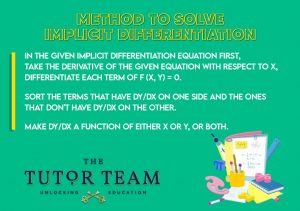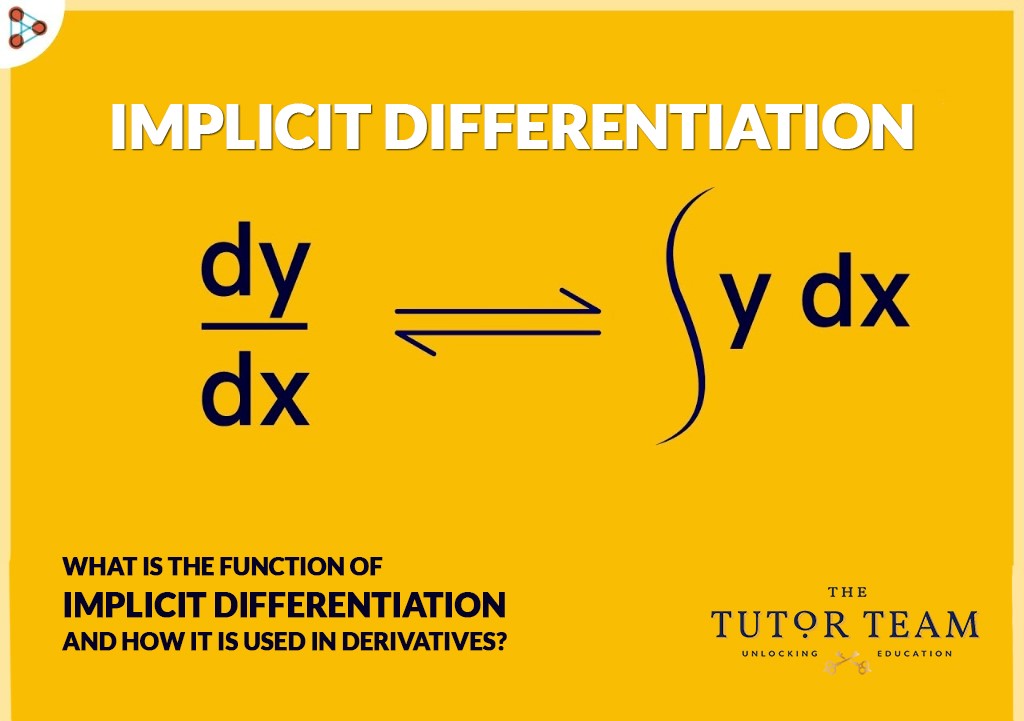Implicit differentiation is one of the types of derivatives used widely in differentiation calculus is a sort of derivative in which the derivative of the equation must be determined. Differentiation calculus is a type of calculus that is mainly used to find the rate of change of the functions. In calculus, it is commonly used to find the derivatives of an algebraic expression. In this post, we’ll look at what implicit differentiation is and how to identify it using a variety of examples.
What is Implicit Differentiation in calculus?
Before starting the introduction of implicit differentiation, we must have a sound knowledge about implicit function as in implicit differential we have to calculate the derivative of implicit functions. The function becomes an implicit function when the dependent variable is not explicitly isolated on either side of the equation.
A function defined in terms of both dependent and independent variables, such as,
X2 + 3Y = 0
is an implicit function. An explicit function, on the other hand, is expressed in terms of an independent variable, such as y = f(x). An implicit function can be easily differentiated without rearranging the function and instead distinguishing each word in the case of differentiation. Because y is a function of x, we’ll use the chain rule, as well as the product and quotient rules.
The technique of obtaining the derivative of an implicit function is known as implicit differentiation. Explicit and implicit functions are the two types of functions. The dependent variable “y” is on one of the sides of the equation in an explicit function of the type y = f(x). However, having ‘y’ on one side of the equation is not necessarily required. Consider the following functions, for example:
- X3 + 3Y = 5
- xy2 + cos(xy) = 0
Even though ‘y’ is not one of the sides of the equation in the first case, we can still solve it to write it as y = 1/3 (5 – x3), and it is an explicit function. However, in the second situation, we cannot readily solve the equation for ‘y,’ and this sort of function is known as an implicit function. Implicit differentiation calculator can be used for the accurate results for this type of derivative.

7 WAYS TO GET THE BEST RESULTS FROM PRIVATE TUTORING
Method to solve this type of differentiation
We can’t start with dy/dx in the process of implicit differentiation since an implicit function isn’t of the type y = f(x), but rather f (x, y) = 0. It’s important to be aware of derivative rules like the power rule, addition rule, product rule, exponent rule, quotient rule, chain rule, and so on. The step-by-step method to find the implicit differentiation is mentioned below.
- In the given equation, first, take the derivative of the given equation with respect to x, differentiate each term of f (x, y) = 0.
- Sort the terms that have dy/dx on one side and the ones that don’t have dy/dx on the other.
- Make dy/dx a function of either x or y, or both.

How to evaluate the problems of implicit differentiation?
The steps for performing implicit differentiation have been demonstrated. Is there a certain formula we came across along the way? No!! There is no specific formula for implicit differentiation; instead, to obtain the implicit derivative, we follow the processes mentioned above.
Important Points to Remember About Implicit Differentiation:
- When the function is of the form f(x, y) = 0, implicit differentiation is the process of determining dy/dx.
- Simply differentiate on both sides and solve for dy/dx to discover the implicit derivative dy/dx. However, whenever we are distinguishing y, we should write dy/dx.
- In the process of implicit differentiation, all derivative formulas and techniques must be applied as well.
To understand this concept let’s take some examples.
Example 1
Find the implicit differentiation of x3 + y2 = 9
Solution
Step 1: write the given function.
x3 + y2 = 9
Step 2: Apply d/dx on both sides of the given equation.
d/dx (x3 + y2) = d/dx (9)
Step 3: Apply the rule of the differentiation.
d/dx (x3) +d/dx (y2) = d/dx (9)
Step 4: Solve the derivative.
3x2 + 2y dy/dx = 0
Step 5: Arrange the above equation to get dy/dx.
3x2 + 2y dy/dx = 0
2y dy/dx = -3x2
dy/dx = -3x2/2y
Thus, the implicit differentiation of the given function is dy/dx = -3x2/2y.
Example 2
Find the implicit differentiation of 4x2 + 2y2 = 6y
Solution
Step 1: write the given function.
4x2 + 2y2 = 6y
Step 2: Apply d/dx on both sides of the given equation.
d/dx (4x2 + 2y2) = d/dx (6y)
Step 3: Apply the rule of the differentiation.
d/dx (4x2) +d/dx (2y2) = d/dx (6y)
Step 4: Solve the derivative.
8x + 4y dy/dx = 6dy/dx
Step 5: Arrange the above equation to get dy/dx.
8x + 4y dy/dx = 6dy/dx
4y dy/dx = 6 dy/dx – 8x
so 4y dy/dx – 6 dy/dx = – 8x
(4y -6) dy/dx = -8x
dy/dx = -8x / (4y – 6)
so dy/dx = -8x / 2(2y – 3)
dy/dx = -4x / (2y – 3)
Thus, the implicit differentiation of the given function is dy/dx = -4x / (2y – 3). You can also find the antiderivative or integral of a function using antiderivative calculator.
Example 3
Find the implicit differentiation of x2 + y2 = 7y2 + 7x
Solution
Step 1: Write the given function.
x2 + y2 = 7y2 + 7x
Step 2: Apply d/dx on both sides of the given equation.
d/dx (x2 + y2) = d/dx (7y2 + 7x)
Step 3: Apply the rule of the differentiation.
d/dx (x2) +d/dx (y2) = d/dx (7y2) + dy/dx (7x)
Step 4: Solve the derivative.
2x + 2y dy/dx = 14y dy/dx +7
Step 5: Arrange the above equation to get dy/dx.
2x + 2y dy/dx = 14y dy/dx +7
2y dy/dx = 14y dy/dx +7 – 2x
so 2y dy/dx – 14y dy/dx = 7 – 2x
(2y -14y) dy/dx = 7 – 2x
dy/dx = (7 – 2x) / (2y -14y)
Thus, the implicit differentiation of the given function is dy/dx = (7 – 2x) / (2y -14y).
Summary
A function defined in terms of both dependent and independent variables, such as X2 + 3Y = 0, is an implicit function. Implicit differentiation is a process of finding dy/dx of the given implicit function equation such as f (x, y) = 0. Implicit differentiation has no specific formula to solve the problems rather it has some steps to solve the problems of implicit differentiation.
By following those steps we can easily solve any problem related to this type of differentiation.


